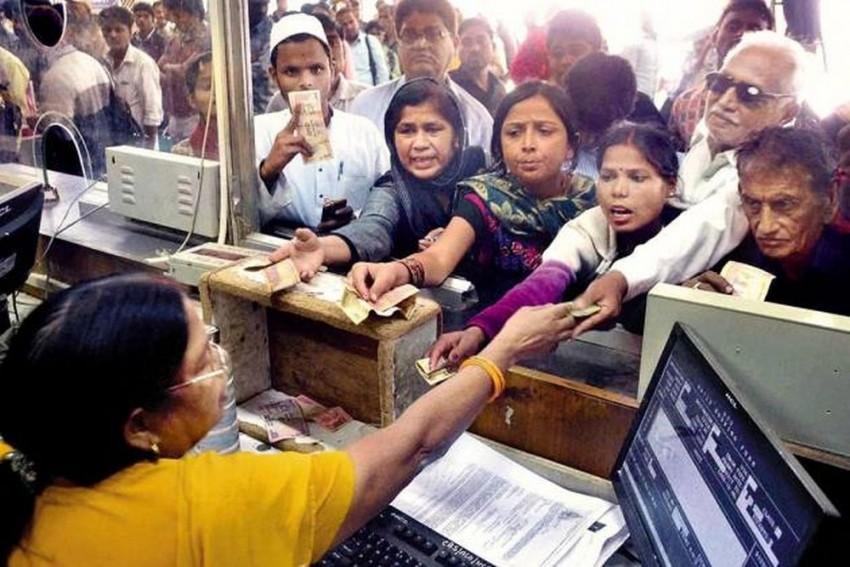REPLUG: Demonetisation has Been an Utter Failure on all Fronts
at great inconvenience to the people.

Image Courtesy: PTI
In the entire history of post-Independence India, no single economic measure has been as devastating for the people and as utterly futile in achieving its stated objectives, as the demonetisation of currency notes of Rs 500 and Rs 1,000 denomination, decreed by the Narendra Modi government on November 8, 2016.
The fact that it did not achieve its stated objectives was not unforeseen. On the contrary, it was obvious to every economist that demonetisation was the height of folly even as it was announced, which is why it was opposed by all, except a handful of “climbers” keen to please the government.
The government had mentioned three objectives of the move: to eliminate black money, to get rid of counterfeit notes and to attack terror funding. Of these, the last two were add-ons that everybody knew did not carry much credibility. A study by the Indian Statistical Institute had estimated counterfeit currency to be a minuscule proportion of total currency. Hence, the sudden demonetisation of 85% of the country’s currency for the sake of getting rid of a minuscule amount of counterfeit currency could not be taken seriously as an argument.
Likewise, terror funding occurs through diverse routes and nobody seriously thought that demonetisation would stop terror funding or even hurt it temporarily. The real objective was to eliminate black money; and believing that demonetisation would do so, betrays the Modi government’s total lack of understanding of the black economy, and hence of the economy in general.
Demonetisation as a solution to the problem of black money was based on an understanding of “black money” derived from Bollywood films, namely, a stack of currency notes stuffed in pillows, or in suitcases kept under beds. In fact, there is no such thing as “black money”, only a number of economic activities that are not officially declared, primarily for the purpose of avoiding taxes.
All economic activity requires money for its operation; and undeclared activities are no exception to it. The money that is used for carrying on these undeclared activities may be loosely called “black money”, but these do not remain inactive, as a hoard stuffed into pillows and suitcases.
The use of money can be shifted from declared to undeclared economic activities, so that even if the Modi government had succeeded in “killing” a whole lot of money used in the black economy, whose owners, as expected by the government, did not turn up at various banks for converting their demonetised currency holdings into new money, this would still not have killed black economic activities. Money would just have shifted from the “white” to the “black” economy, that is, from declared to undeclared economic activities, causing at the most a shortage of money in general and hence a general recession, but not the elimination of the “black” economy.
In the event, however, 99% of the disabled currency notes came back to banks for conversion into new notes. Nothing demonstrates the utter failure of demonetisation as clearly as this fact. The government’s expectation was that “black” money would not be exchanged for “white” because their possessors would be too scared to do so, for fear of being caught if they turned up with large amounts whose presence in their possession they could not explain.
The ruling Bharatiya Janata Party spokespersons even suggested that if a certain amount of money did not turn up for conversion, say Rs 100, then, currency being the liability of the Reserve Bank of India, Rs 100 of liability would disappear from the RBI’s balance sheet, which could be substituted by printing new money and this new money could be simply distributed among the people.
Estimates of the amounts that could be so distributed among the people were bandied about. But when 99% of disabled currency notes turned up for conversion, it showed not only how absurd these calculations had been, but also how utterly naïve had been the government’s expectation that “black” money would be disabled by demonetisation and eliminated from the economy. The entire exercise, therefore, turned out to be a mere act of converting old notes into new ones, and that too at great inconvenience to the people.
But the inconvenience did not end there. Demonetisation was not just a game played out, with no great consequence (apart from the pain of queueing up for hours outside banks which incidentally claimed many lives). It had severe economic consequences for the economy. The currency notes that were demonetised amounted to nearly 85% of the economy’s total cash; and 85% of total cash being immobilised suddenly had effects that were crippling in both the short and the long-term.
Between demonetisation and the near complete return of old currency to the banking system, there was a gap of about nine months, during which the economy faced a shortage of currency, and the petty production sector that primarily uses cash transactions, was the worst victim of it.
Farmers had difficulty selling their rabi harvest. Since they had no cash for buying seeds and fertilisers for the next crop, they took loans. Likewise, many artisans and petty producers in the non-farm sector, who could not sell their output, had to take loans to buy their inputs. And if they did not buy inputs and interrupted their production instead, then their workers who became unemployed had to take loans to return home and feed themselves during the period of unemployment.
Demonetisation, therefore, had the effect of making the petty production sector, or “the informal sector”, indebted; and this sector, it must be remembered, employs nearly 94% of the workforce of the country.
This debt left a permanent scar on the sector. Where there was interruption of production, the debt incurred in the interim remained a permanent debt. Where output was stored and not sold, but production continued nonetheless, even if the principal of the debt incurred in the interim to buy new inputs, could be paid back, the interest, which could be quite high because of the distress under which debt was incurred, could not be. It continued to remain like an albatross around the neck of the producers.
The petty production sector, therefore, witnessed a permanent increase in its level of debt; and since even at the best of times, large segments of this sector can manage just about simple reproduction, this increase in debt pushed many such units into non-viability.
As a result, not only was there a short-run disruption of production, especially arising from the petty production sector’s inability to cope with the demonetisation-induced cash shortage, but there was also a long-run debilitation of this sector which could not but affect the workforce employed by it. This debilitation and impoverishment continues to this day.
The damage, however, was not confined to the petty production sector alone. Even the organised sector was hit by demonetisation for a different reason. The petty production sector, either directly or via the consumption demands of those engaged within it, buys a number of goods from the organised sector and when it suffered a recession, or more generally a loss of income, its demand for organised sector’s goods fell, which in turn affected the latter. Thus the entire economy, one way or another, was adversely affected by demonetisation.
Meanwhile, the BJP, ever inventive in its lies, had started spinning another story. Corruption and black money, it argued, were the result of the use of cash in the economy; if cash could be substituted by non-cash means of settling transactions, then there would be a record of all such transactions which would bring down corruption and black money. Modi was projected as a “visionary”, modernising the economy in a manner that would eliminate all scope for corruption and black money.
This claim flew in the face of obvious facts: there was no connection between corruption and the use of cash, captured, for instance, by an economy’s cash-GDP (gross domestic product) ratio. Germany and Japan had much higher cash-GDP ratios than India but were palpably less afflicted by corruption. And interestingly, the cash-GDP ratio that had gone down temporarily after demonetisation from its original level of 12%, climbed back again and is currently 14%. Thus, even by the BJP’s own argument in this regard, demonetisation has been a failure.
How can anybody be so indifferent to people’s suffering as the Modi government was in decreeing demonetisation? The answer lies in its desire for “shock and awe”, and the belief that the more people suffer, the more they would feel convinced that the government could not be inflicting so much suffering on them unless it was indeed serving some higher purpose. The combination of ignorance, arrogance and the desire for “shock and awe” on the part of a government can be quite lethal, as the Indian people have learned to their great cost.
Get the latest reports & analysis with people's perspective on Protests, movements & deep analytical videos, discussions of the current affairs in your Telegram app. Subscribe to NewsClick's Telegram channel & get Real-Time updates on stories, as they get published on our website.
























